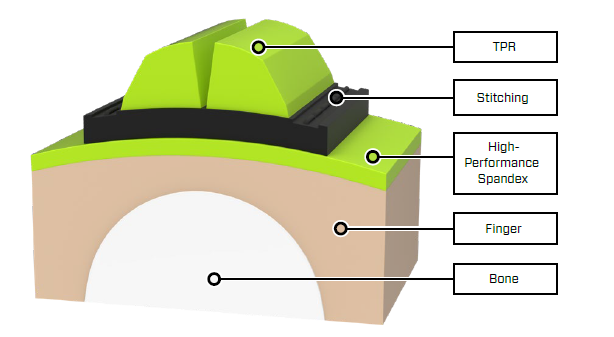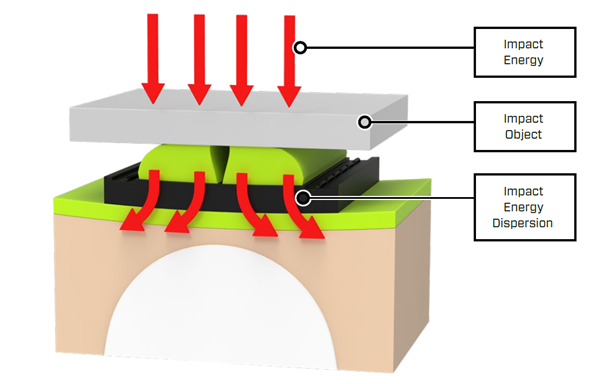Product Finder
Let us help you find the best solution to fit your needs.
View ProductsImpact gloves are a type of personal protection equipment (PPE) designed to prevent the occurrence of hand injuries in occupations where high impact is a risk. Whether you work in the oil and gas industry, mining, or manufacturing, impact-resistant gloves are essential to the safety of the work environment.
OSHA estimates that 71% of all hand injuries could be prevented with the appropriate use of PPE, specifically safety gloves. The hazardous and unpredictable environments associated with certain occupations can result in serious hand injuries. These injuries which occur from not wearing gloves are not only painful but also cost both the employee and employer time and money. According to the National Safety Council, a hand injury can cost between $540 to $26,000.1
Without wearing the correct impact protective gloves, workers could break one of the 27 bones in the hand and potentially damage muscles, tendons, and ligaments. That is why the right type of impact gloves are an essential investment to make before an injury occurs, to ensure employees are healthy, safe, and efficient.
RINGERS® impact gloves from Ansell provide hand protection against occupational impact hazards in a variety of ways. The RINGERS® signature impact protection system uses thermoplastic rubber, called TPR, which disperses impact energy, reducing the force of impact and impact injuries on fragile bones. Each thermoplastic rubber TPR glove is fine-tuned to maintain dexterity, flexibility, and comfort, without compromising protection from impact hazards. See the two tables below for a further understanding of how gloves including impact protection work.

Glove Designs: TPR Cross Section
Each piece of our thermoplastic rubber is securely stitched to the backside of the glove. To maintain a full range of motion, our designs meticulously follow the anatomy of the hand. Our TPR is constructed in a variety of shapes and sizes to suit the purpose and use of the gloves. Heavy-duty jobs require more extensive impact protection covering a larger portion of hands than lighter-duty jobs.

Glove Designs: Impact Dispersion
TPR is expertly designed with precision in order to effectively disperse energy from an impact. Our unique design combines TPR attributes such as thickness, shape, hardness, softness, and color to produce the most effective impact glove in the world.
Many of Ansell's work gloves include TPR impact protection combined with cut-resistant liners for many types of occupational cut hazards. Several Ansell impact gloves are dipped in nitrile to enhance wet grip and contain extra palm coating to reduce vibrations. Ansell also has gloves that provide protection against arc flash and many more gloves that are even touchscreen compatible. View the breadth of Ansell's PPE portfolio and find the impact glove that’s right for you.
Ansell's impact-resistant gloves can provide several different types of hand protection that are suited for many industries and jobs. Impact gloves are most important when the risks of injury are the highest. This is especially the case for the oil and gas, construction, mining, and manufacturing industries. But it is not uncommon to face impact hazards to the hand and finger in the automotive, chemical, and aerospace industries as well.
Naturally, Ansell's impact protection gloves provide excellent protection from impact hazards, but they also can provide cut, vibration, and chemical protection for many different types of tasks. With Ansell’s offering, workers have the confidence that comprehensive hand protection provides, allowing them to tackle any risk they encounter. There are hundreds of different tasks that Ansell's impact-resistant gloves are great for, but a few of them are: Loading and hauling, operating heavy machinery, mixing or loading chemicals, hydraulic repair, and pumping work.
Whether you work in the oil and gas industry, mining, or manufacturing, impact-resistant gloves are essential to the safety of the work environment. In 2019, a new regulatory standard, ANSI/ISEA 138-2019 American National Standard for Performance and Classification for Impact-Resistant Gloves, establishes "minimum performance, classification, and labeling requirements for hand protection products designed to protect the knuckles and fingers from impact forces, while performing occupational tasks."
There are three performance levels that will offer numerical representation for the impact protection the glove provides. The rating of the glove will reflect the lowest performance level recorded across multiple tests. Level one will be the lowest rating for impact protection, and level three will be the highest.
Testing calls for specific preparation and conditioning of the glove, with the highest mean transmitted force (lowest rating) between the tests recorded. Meaning if the knuckle rating is "two", but the finger rating is "one", the glove is assigned a "one" rating.
Learn more about the standards and testing
As a leader in glove innovation, Ansell is here to walk you through impact standards for gloves and how they provide transparency when it comes to comparing impact-resistant gloves. This means you can be certain your selected protective hand glove is built for impact.
1.https://ohsonline.com/articles/2020/02/01/a-new-year-of-hand-safety.aspx